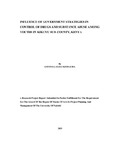Influence of government strategies in control of drugs and substance abuse among youths in Kikuyu sub-county, Kenya
Abstract
No county is immune to the consequences of drugs and substance abuse and trafficking.
Their social ills which include unemployment, poverty and crime are devastating many
families and communities. Empirical data has shown that drug abuse is a major problem
conforming Kenya today especially among the youth. In Nairobi alone, it is estimated
that 50% of the students have in the past taken drugs. Additionally, it has been alleged
that children as young as 10 years are abusing alcohol. Though the government has put in
place measures to reduce drugs abuse, there is evidence that the problem is far from over.
This study therefore sought to establish the influence of government strategies in control
of drugs and substance abuse in Kikuyu Sub County. The objectives of the study were to
establish how economic empowerment and establishment of recreation facilities,
information and education, legislation and enforcement of laws and treatment and
rehabilitation as government strategies influence control of drugs and substances abuse.
A descriptive survey study was designed to collect quantitative and qualitative data to
help answer the research objectives. The study targeted a total of 3563 respondents
comprising of youths from 227 youth groups registered under the Ministry of Labour,
Social Security and Services as well as national government officers. Data was collected
using questionnaires for youths and interviews for national government officers.
Qualitative data obtained was analyzed using content analysis while quantitative data was
edited, coded and entered into SPSS version 20 computer software. Specifically,
descriptive statistics in the form of frequencies, percentages, mean and standard deviation
were used to show various relevant distributions. On ethical issues participants were
allowed to choose whether or not to participate in the research and the researcher assured
them that the information gathered was confidential and for academic purposes only.
Operationalization of the variables was explained and details covering indicators,
measurement scale, types of data analysis and tools of data analysis presented in table
3.1. Data was analysed, presented and interpreted. Questionnaire return rate was 95.6%
out of a sample of 360. Demographic characteristics of the youths were age, gender,
education, employment and monthly income. 71.1% of the respondents were males and
28.9% females. Data on each of the four strategies was presented and interpreted. 94.5%
of the respondents were youths and 1.1% National government officers. The study found
that economic empowerment and establishment of recreation facilities, legislation and
enforcement of laws, treatment and rehabilitation influence control of drugs and
substance abuse positively, while the influence of information and education was
negative. Youths’ age and level of education has no influence on their tendency to use
drugs and substances but gender, employment status and income have significant
influence. The study recommends adoption of strategies to encourage youths to utilize
recreation facilities and access economic empowerment programmes. It also recommends
initiation of training programmes on drugs and substances targeting the youths,
sensitization of youths on all drugs and establishment of a rehabilitation centre in Kikuyu
Sub-County. Suggested areas for further research are; strategies to control drugs and
substance abuse by non state actors, capacity of legislations to deter drugs trafficking,
influence of government taxation policies on control of abuse of licit drugs and
substances and a similar study in an urban area. APA System has been used for
references. Appendixes cover, letter of transmittal, research authorization letter, permit,
questionnaire, interview guide, budget and time frame.
Publisher
University of Nairobi
Collections
- Faculty of Education (FEd) [6022]

